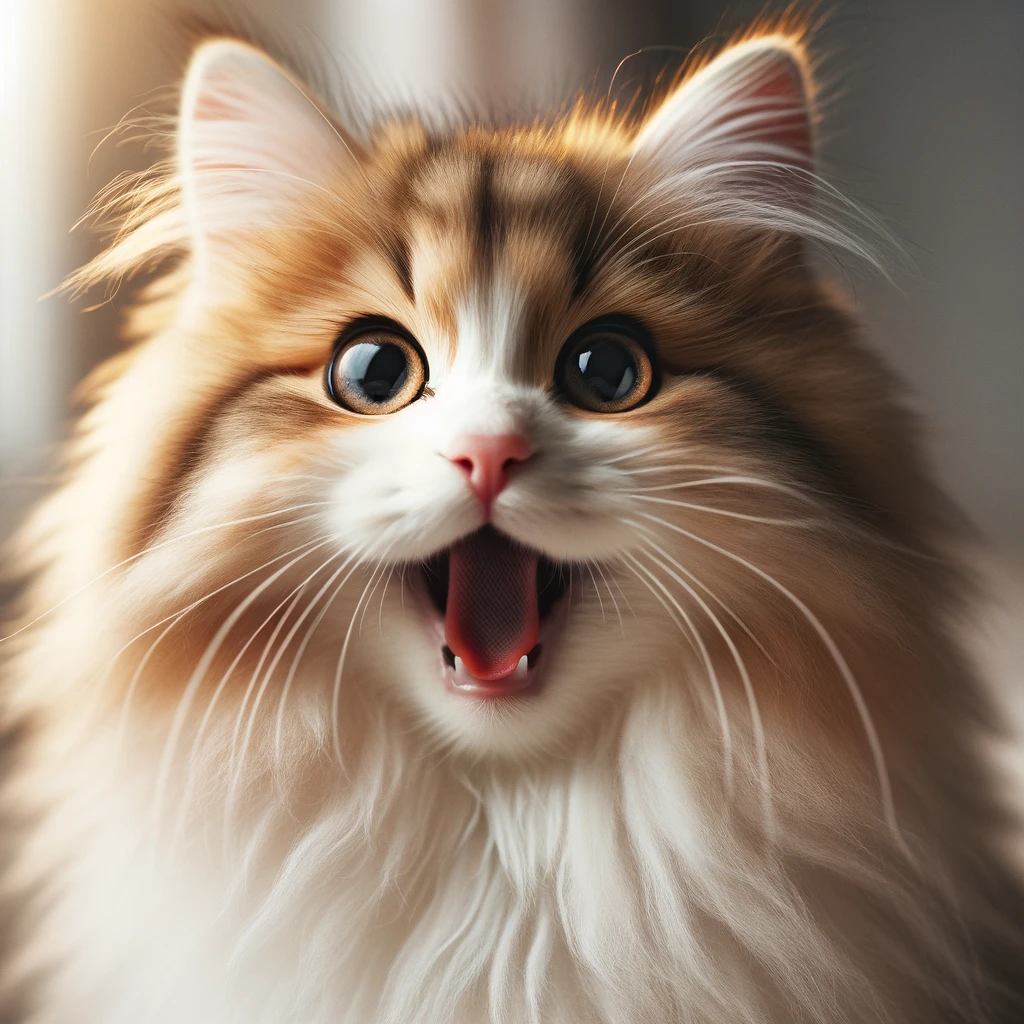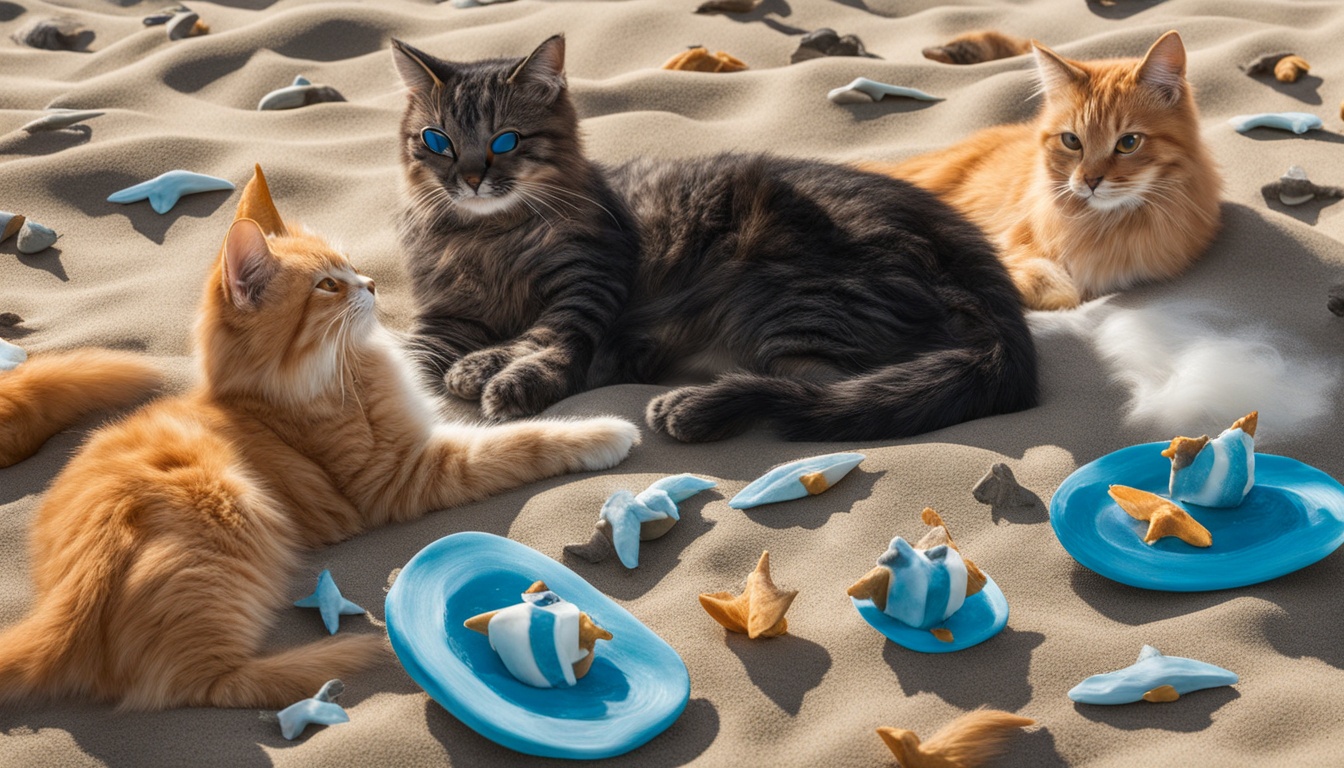As an Amazon Associate I earn from qualifying purchases.
In the village of Petäjävesi, Finland, a special group of cats catches people’s eyes. Their coats are unique, like the ombré pattern of salty licorice candies. They start dark at the roots but get lighter towards the ends, reminding you of your favorite salty licorice treat.
Researchers from the University of Helsinki wanted to know more about these cats. They worked with pet care companies, cat owners, and breeders. Together, they found out that a specific gene mutation causes the unique fur color. They named this gene “salmiak”, after the famous Finnish treat.
Key Takeaways
- Petäjävesi, Finland is home to a unique breed of cats with ombré fur patterns reminiscent of salty licorice or black licorice candies.
- Researchers at the University of Helsinki collaborated with pet care companies, cat owners, and breeders to study the DNA of these exceptional feline treats.
- A novel gene mutation named “salmiak” was identified as responsible for the cats’ distinctive fur coloration.
- The research findings open up possibilities for developing a designer breed of salty licorice cats, while prioritizing responsible breeding practices.
- The insights gained from studying the KIT gene could contribute to advancing our understanding of related genetic disorders in humans.
What Are Salty Licorice Cats?
Salty licorice cats have a special fur pattern that looks like the Finnish candy called salty licorice. Their fur starts dark at the roots and turns white towards the ends. This makes them stand out like no other breed.
Distinct Ombré Fur Pattern
The ombré fur color of salty licorice cats is their key feature. Their coat changes from dark to light, creating a smooth and beautiful gradient. This effect is not common in other cat breeds.
Resembling Tuxedo Cats
The white on their chests looks like tuxedos, but the real magic is in the ombré colors. The way their fur changes from dark to light captures everyone’s attention. It’s what makes them unique.
First Observed in Finland
In 2007, the special fur look was found in Petäjävesi, Finland, for the first time. These salty licorice cats have since gained a global fanbase. Cat lovers and scientists are curious about them, leading to more studies.
| Characteristic | Description |
|---|---|
| Coat Pattern | Ombré fur, dark roots fading to white tips |
| Origin | Petäjävesi, Finland (first observed in 2007) |
| Resemblance | White chest like tuxedo cats, but distinct ombré strands |
| Nickname | “Salmiak” cats, inspired by Finnish salty licorice candy |
Salty licorice cats are not only beautiful but also mysterious. Their unique look has sparked interest from scientists and cat lovers around the world. Everyone wants to know more about them.
The Genetic Discovery
Top-notch research found the genetic secret of salty licorice cats. It was a team effort including cat lovers, the University of Helsinki, and a pet care company. The university had a biobank with lots of cat blood samples. Plus, the company specialized in genetic tests. And, there were many cat owners and breeders eager to help.
Collaboration Between Researchers and Cat Owners
The research worked because cat lovers gave samples from their pets. The team looked into the genes of five salty licorice cats. They made an amazing discovery.
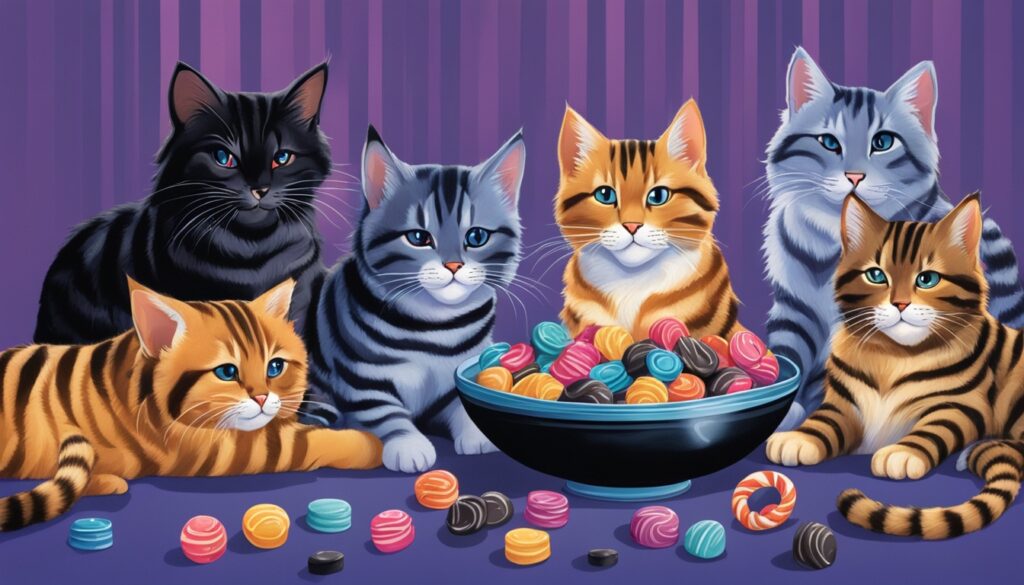
Unique Gene Mutation Identified
By carefully studying the genomes of two special cats, they found a new gene change. This change in the KIT gene was named “w-salm.” It explained why these cats had a unique, salty candy-like fur color.
They saw that the five salty licorice cats had two special gene copies. They were different from other cats in the biobank. Knowing this made future study of this unique trait possible.
| Genetic Variant | Gene | Fur Pattern |
|---|---|---|
| w-salm | KIT | Salty licorice ombré |
The University of Helsinki and Wisdom Panel teamed up to learn more about feline health. Their work was key in finding the salty licorice gene. This discovery could lead to better health for cats in the future.
The KIT Gene and Its Role
The KIT gene is key for hair color in various species, like cats. It’s very important to scientists who study how cats’ fur looks. For example, in salty licorice cats, a special change in this gene makes their fur look unique.
Controlling Hair Color
The KIT gene helps control hair color. It makes many different colors and patterns in animals. For those who love cats, this gene is very special. It helps create the many colors we see in our beloved pets.
This includes everything from black and white patterns to orange tabby cats. The KIT gene is behind all these beautiful cat colors.
Potential Health Implications
Some changes in genes that affect fur color can also cause health issues, like hearing problems in cats and dogs. But the unique case of the salmiak mutation seems harmless.
Yet, it’s worth knowing that the KIT gene also helps make proteins in important body cells. So, changes in this gene could affect more than just fur color. They might influence other body functions too. This shows how complex the link between genes and health is.
Scientists are looking deeper into the salty licorice cats’ fascinating fur. They are being careful to watch for any health issues. By learning more about the KIT gene, they hope to keep these amazing cats healthy. They also aim to discover more about what makes their fur so unique.
Salty Licorice Cats: The Name
These cats have a unique fur pattern. It starts dark at the roots and fades to white. This pattern caught the eye of scientists. They named it “salmiak,” after the Finnish word for salty licorice.
Inspired by Finnish Candy
The name comes from a Finnish candy called salty licorice. It’s a favorite savory confection in Finland. The candy’s sweet licorice taste with a salty zing mirrors these cats’ unique look.
Resembling Black Licorice with Salt Specks
They look like salted black licorice. Their fur changes from dark to light, just like the candy. This makes their coats look like the famous Finnish salty licorice sticks.
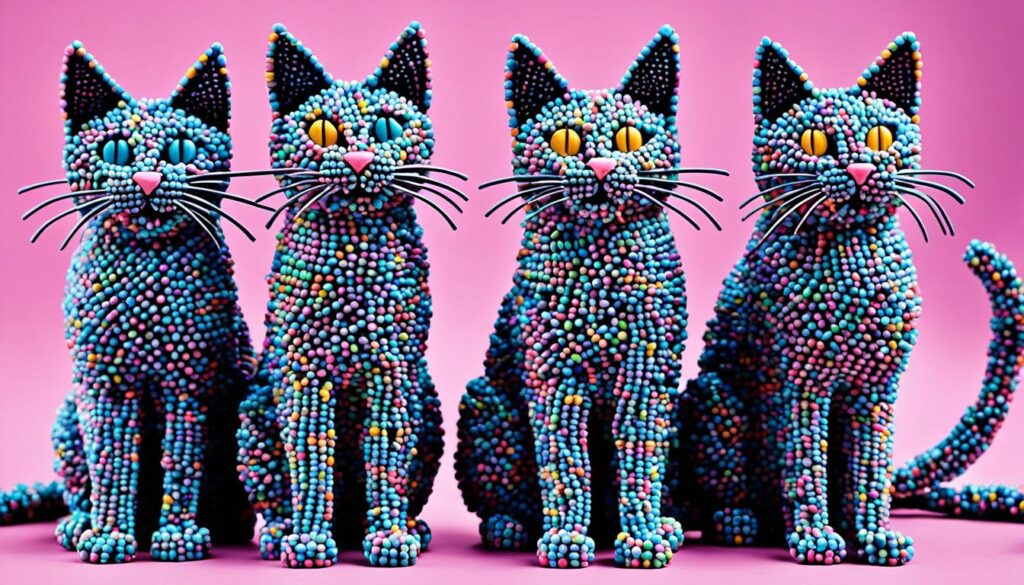
| Coat Appearance | Gene Variant | Gene Copies |
|---|---|---|
| Salty Licorice Pattern | w-sal | Two copies of recessive gene |
| Partially Colored | w-sal | One copy of recessive gene |
| Normal Coloration | Wild-type | No copies of recessive gene |
Cat lovers all over adore this unique fur pattern. It makes these cats a special treat. Anyone who loves fanciful things would enjoy these felines.
Salty Licorice Cats’ Genetics
The special salmiak fur look in salty licorice cats comes from a hidden gene in the KIT gene. A team from the University of Helsinki looked into this, studying DNA from five salty licorice cats and 178 normal ones.
Recessive Gene Variant
All five salty licorice cats had two copies of the special gene. This gene makes their fur look like salmiak. Most cats tested didn’t have this gene at all.
Varying Levels of Expression
Salty licorice cats don’t all look the same. Some have a clear ombré effect, with dark roots fading to white. Others, though, show a smoother color change.
People who love cats find these unique looks very interesting. As we learn more about their genes, salty licorice cats become more fascinating. They show us the amazing variety in the world of cats.
Potential for a Designer Breed
The salty licorice fur pattern’s genetic secret is out. This news lights a spark for creating a designer cat breed. Many cat lovers are excited about the idea of owning salty licorice cats.
Growing Interest in Unique Appearance
Feline fans from all over are charmed by the salty licorice fur. It comes in dark at the roots and fades to white at the tips. This look, similar to Finland’s favorite salty candy, adds even more intrigue and desire for these exotic furry companions.
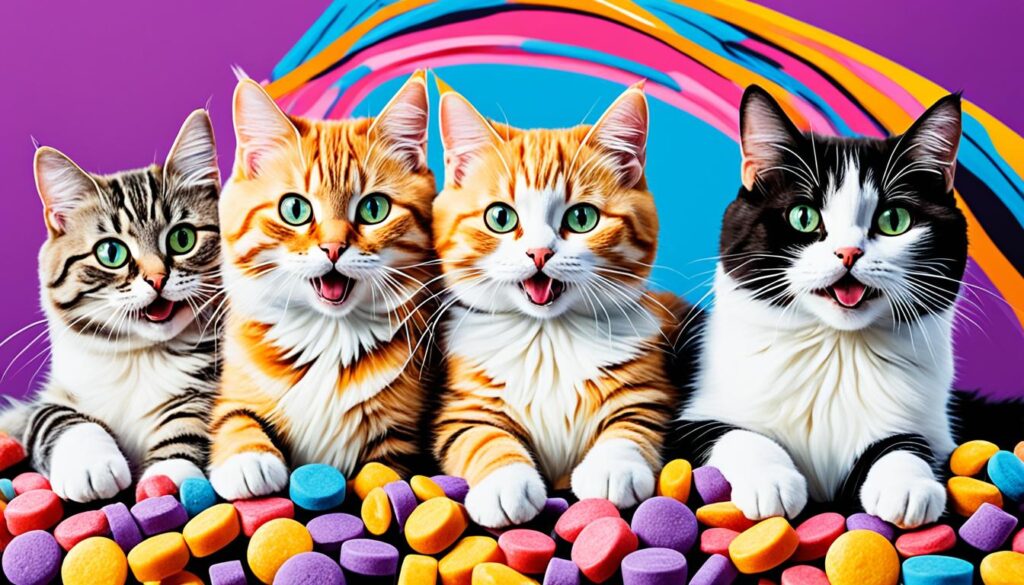
Health Considerations
The salty licorice fur style is not just cool; it’s crucial to watch these cats’ health. With special testing, we can confirm that any future savory confections cat breeds are safe. This means no bad genes or health problems related to the fur shade.
- Responsible breeding practices are crucial for maintaining the well-being of salty licorice sticks cats.
- Close observation and genetic testing can prevent the transmission of dangerous genes during selective breeding.
- The long-term health implications of the salty snacks fur pattern should be carefully studied before widespread breeding.
With more and more people showing interest in these unique feline treats, a deep focus on their health is a must. Mixing care with breeding is key to making a new black licorice designer cat breed responsibly and ethically.
Salty Licorice Cats and Biobanking
The University of Helsinki’s feline biobank allowed groundbreaking genetic research. They focused on the unique salty licorice cats. The biobank contains over 5,000 blood samples from more than 40 cat breeds. This rich diversity aids scientific studies.
Feline Biobank at University of Helsinki
Experts found the salty licorice cats in Petäjävesi, Finland, intriguing. They looked to the university’s biobank for clues. By comparing DNA from these cats and normal ones, they found a special gene. This gene, called w-sal, is behind the cats’ unusual fur patterns.
Potential for Advancing Feline Health Research
The biobank works with Wisdom Panel, a top pet DNA testing company. Together, they research the KIT gene that affects color and health. Understanding this gene could help with feline and human health issues.
At the University of Helsinki, work continues on feline genetic research. The project on salty licorice cats is a prime example. It shows how studying feline genes can help both cats and people.
| Genetic Findings | Sample Size | Highlights |
|---|---|---|
| Salty licorice cats | 5 | Each had two copies of the recessive w-sal gene variant |
| Normal-colored cats | 178 | Tested for the w-sal variant associated with salty licorice coloration |
| Finnish cats studied | 180 | Identified the w-sal variant linked to the unique salmiak coat pattern |
| Cats from other regions | Not specified | The w-sal variant was not found in cats from Romania and the U.K. |
Salty Licorice Cats and Their Future
The find of salty licorice cats with their awesome ombré fur has grabbed the attention of both cat lovers and savory confections fans. Thinking about a new feline treats breed might make some salty licorice sticks fans happy. But, scientists warn health issues linked to their unique look need careful checking.
Monitoring Health Implications
A study in the journal Animal Genetics on May 9 talked about cats with cool ombré fur. At the University of Helsinki, they checked 5,000 blood samples from 40 cat breeds. They looked at the entire genetic makeup of two salty licorice cats to find how their fur gets those cool colors.
All five salty licorice cats had the w-sal gene, and some other cats had it once. The KIT gene controls hair color, blood cells, and reproduction cells. So, long-term health studies on these cats are important before more of them are bred.
Potential for Selective Breeding
Creating a new designer breed of salty licorice cats sounds cool. But, it’s only good if breeders will take good care of their health with special genetic tests. The University of Helsinki and Wisdom Panel work together on projects. They want to understand how to avoid genetic diseases in cats, showing why careful breeding is key.
| Gene | Function | Salty Licorice Cats |
|---|---|---|
| KIT | Controls hair color | Carries w-sal variant |
| KIT | Encodes proteins in red blood cells | Potential health implications |
| KIT | Encodes proteins in reproductive cells | Genetic testing required for breeding |
The KIT gene is key to making salty licorice cats look special and working hard inside their bodies. Keeping a close watch and using specific genetic tests are crucial for a new generation of these feline treats. We need to be sure they’ll be healthy before we start making more.
Impact on Human Health Research
The salty licorice cats led to an amazing discovery. Their unique genetic mutation had never been seen before. This finding could lead to big steps in human health. This is because genes are often very similar across animals and people. So, learning from these cats could help scientists better health in humans too.
Similarities Across Mammalian Species
One key gene in cats, the KIT gene, does more than just give them their color. It also affects how their bodies work. By looking at a specific part of this gene in cats, researchers hope to learn more about genetic problems in people. This way of studying genes lets us see how they work in different creatures.
Advancing Understanding of Genetic Disorders
The University of Helsinki and Wisdom Panel are working together. They want to find the causes of health problems in cats. Through genetic testing and studying samples, they might make breakthroughs in human medicine. By studying the KIT gene’s many roles, they could find new leads on human health issues.
The table shows some big discoveries about the salty licorice cats. These findings could have a big impact on human health research:
| Genetic Aspect | Findings | Potential Impact |
|---|---|---|
| KIT Gene Variant | The w-sal variant controls hair color and encodes proteins in red blood cells, sperm, and egg cells. | Learning about the KIT gene might help with conditions that impact skin, blood, and chances to have children. |
| Cross-Species Similarities | Genes often show similarities between different mammals. | The research on cats could boost our understanding of human genetic issues. |
| Biobanking Collaboration | The University of Helsinki has 5,000 cat blood samples in its biobank. This lets it work with Wisdom Panel on research. | Using this data could uncover what causes diseases in cats and people, looking at genes and the environment. |
The salty licorice cat story is fascinating to many. Its genetic secrets could be vital for human health too. By looking at how genes work in different animals, researchers hope to find new ways to understand and fight genetic diseases in all of us.
Embracing Feline Diversity
Salty licorice cats are special with their unique ombré fur. They were first seen in Petäjävesi, Finland. These cats have become famous, showing us how diverse cats can be.
Celebrating Unique Traits
These cats look different but in a good way. They remind us how creative nature can be. Their fur looks like a mix of salty licorice and white. It’s important to celebrate their uniqueness.
Responsible Breeding Practices
Many people might want to breed these unique cats. But, we must be careful. We need to make sure they stay healthy. Breeding should focus on the cats’ well-being. This way, their beauty and health are both looked after.
| Publisher | Publications | Citation Percentage |
|---|---|---|
| Wiley | 2 | 40% |
| Multidisciplinary Digital Publishing Institute (MDPI) | 1 | 20% |
| Springer Nature | 1 | 20% |
| Frontiers Media S.A. | 1 | 20% |
This table shows how much research there is on these cats. It points out that many publishers study them. Wiley is the main publisher. They’ve done the most and have the highest percentage of citations. The others each had just one study.
Conclusion
The discovery of salty licorice cats in Finland has amazed many, including researchers and cat lovers. Scientists, pet companies, and cat parents worked together to find a rare gene. This gene causes the ombré color on the cats’ fur. Future crossbreeding should follow ethical guidelines. And, we must watch out for any health issues related to their unique color.
Finding the KIT gene, which affects the cats, may also help our human health studies. Salty licorice cats show us how diverse and surprising nature can be. Whether you love savory confections or just love furry companions, these cats are truly special. They show the ongoing wonders of our natural world.
These cats, with their licorice twists of fur, highlight the beauty of genetic diversity. While the idea of creating a salty snacks inspired breed is tempting, looking after their welfare is more important. By admiring their unique look and ensuring they’re cared for ethically, we celebrate the amazing variety in the feline realm. We also help push forward important scientific discoveries for all living creatures.
FAQ
What makes salty licorice cats unique?
How was the genetic cause of the salty licorice pattern discovered?
What is the role of the KIT gene in salty licorice cats?
Why are salty licorice cats named after the Finnish candy?
How is the salty licorice pattern inherited?
Could salty licorice cats become a designer breed?
How could the research on salty licorice cats impact human health?
What is the importance of responsible breeding practices for salty licorice cats?
As an Amazon Associate I earn from qualifying purchases.
